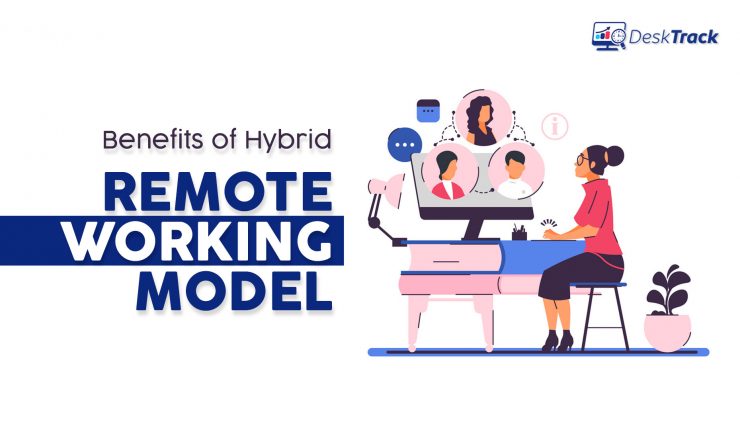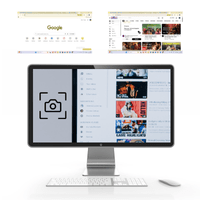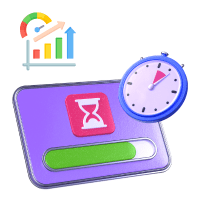
Since the start of the global coronavirus pandemic several years ago, the way we go to work has drastically changed to the hybrid work model. With office buildings remaining empty for years, and even stores and other workspaces displaying nothing but shuttered windows and locked doors, businesses of all kinds have had to find ways of adapting. At this point in the equation, we see the entrance of the hybrid working model.
Now that the pandemic is no longer the threat that it was, businesses are opening back up again and welcoming employees back into the office. So now, to accommodate the major shifts that occurred during the pandemic, many businesses are embracing the hybrid work model, which draws upon the best of both worlds for businesses: remote and in-person.
In this article, we will take a look at the hybrid model of working in India. We will see the rise of remote work during the pandemic that lead up to this moment. Then explore what the hybrid working model is, how it works, and what policies come along with it. After we will take a look at the benefits and challenges associated with the hybrid remote work model. And finally, we will take a look at what the future holds in store for a hybrid mode of working.
Hybrid Model of Working Meaning
Meaning: The hybrid working model is a flexible work approach that enables employees to work from home, office, or anywhere. With this flexibility, they can choose the most productive place to work & do their work with full efficiency.
The Rise of the Hybrid Working Model During the Pandemic
Statistics have revealed that during the pandemic a staggering number of businesses transitioned from in-person to remote or hybrid work platforms during the height of the coronavirus pandemic. From the monumental boom in online retail to the development of ever more advanced video conference software and online collaborative work platforms. The way we work has come to rely much more heavily on the internet and takes place on our laptops and computers instead of in office buildings. And there have been other side effects of this huge shift to a hybrid model of working from home as well.
With no in-person office to go to, many people have taken the opportunity to move homes, or go traveling, taking their work with them. People’s schedules have adjusted to new hours and new time zones. Global companies can connect employees and teammates to collaborate on projects together from afar. Reports show that “small companies are now twice as likely to hire full-time remote workers. And remote work has introduced streamlined processes that cut out some of the time wasters that might occur in the office”.
Of course, there are drawbacks to remote working forms as well. The lack of community and accountability are two strong factors. And some ways of working require more in-person interaction, collaboration, and exchange. So hybrid work model offers a way for businesses to take advantage of the benefits of both forms of working.
What is the Hybrid Working Model?
To start, let’s take a look at just what is hybrid working model is- and what it is not.
There are a few key factors that are in a hybrid work model:
- Some employees work from home, while others work in an office.
- Teams and departments can be split between off-site, remote employees, and on-site employees.
But, you may be wondering, what about those employees who work in the office a few days each week, and then work remotely from home the rest of the time? Are those employees part of the hybrid work model? The short answer is yes:
A hybrid working model does not refer to a combination of in-person and remote work for a single employee.
That would fall more under the category of a flexible work approach. As a result, the WFH hybrid model suggests that some employees are expected to be on-site in-person full-time, while others will work remotely.
Exploring the Hybrid Working Model Policy
For businesses who are ready to embrace the hybrid working model, there is plenty to keep in mind. Business owners and team managers should plan carefully and create policies for a hybrid working model that benefits employees of all types. Offer thoughtful options to help employees and project teams adjust to these new ways of working and collaborating.
Let’s take a look at some important considerations for new businesses embracing the hybrid working model.
Make Sure Everyone Feels Equal
At times, remote employees can feel left out or isolated. Business owners should implement policies that welcome and benefit hybrid model working from-home employees just as they do for employees who work in the office.
To this end, business owners and managers can think about how each employee will feel in the work environment, both digital and in-house. You will want to make sure that none of your employees feel undervalued or less important than any other type of employee. So, to ensure that remote workers feel just as important and appreciated as in-person employees, you may need to create separate types of extra perks and benefits for these different types of employees.
Where employees in the office may be treated to complimentary snacks, tea, and coffee in the break room, special birthday celebrations with the rest of the team, and occasional catered lunches, remote employees should receive comparable benefits.
Here are a few ideas for remedying these differences:
- Think about sending special happy hour gift cards and special birthday gift baskets to your remote crew. Offer them a monthly budget for lunch as a bonus on top of their regular paychecks. Send gift cards to popular coffee shops, so that remote employees can enjoy the same break room perks that in-person employees receive.
- Offer regular one-on-one virtual meetings between managers and remote employees, so that each employee has ample face-to-face time to check in, explain their progress, ask for any necessary clarification, raise any issues, or discuss challenges of the job. Though they are working from home, remote employees should still feel seen and heard in the workspace.
- You can also host virtual company events, like happy hours and themed mixers. Invite the entire company to attend online events, so that in-house and work-from-home employees can connect after work hours.
- If you need ideas on what types of benefits employees would appreciate, you can always extend a questionnaire or survey to your employees so they can participate directly in crafting a positive work environment.
Try to create a positive, inclusive, communicative work environment that welcomes and relies upon all employees, whether they are participating in that environment via digital platforms or in person.
Employees in the office and remotely alike should feel that their careers are progressing and they are moving towards their work goals within the company. Creating a positive and attentive work atmosphere can help both types of employees thrive.
Build a Strong Virtual Community
It can be easy for remote employees to forget that they are part of a community of employees. Strengthen the team spirit for work-from-home employees by utilizing digital communication tools, such as Slack and Google Chat.
These digital work platforms are great for keeping track of projects and organizing work-related tasks. They can also be effective tools for creating a strong sense of community among your digital employees.
- Beyond just checking in and clocking out on these platforms each day, set up separate group chats specifically designed to create social interaction between remote employees. Start a chat for employees to discuss favorite TV shows, weekend plans, or unique hobbies.
- Remote employees can sometimes miss out on the casual social atmosphere of an in-person workplace. Using remote work monitoring software not just to boost productivity but also to create that water cooler type of atmosphere. It will not only help remote employees feel more connected to their work and each other but, can also spark new ideas in the process.
Getting to know each other in this casual online format is a great way to bridge the gap between in-person and virtual employees. Who can get to know each other and feel integrated into the same overall workplace atmosphere?
Adjust Your Communication Expectations
When you walk up to an employee in the office and ask them a question. You will, of course, expect them to acknowledge your presence and answer you right away. However, with remote work styles and digital communication platforms, you may need to adjust your communication expectations.
One of the challenges of working with remote employees is that they may be located anywhere across the globe. This means that their working hours can differ radically from one another, and yours.
Adjusting your communication expectations allows employees to answer questions and prompts promptly but on their schedules. Give your team members all the information about the assigned task, and then let them handle it.
Embracing the hybrid work model means that you will need different ways of managing and overseeing the progress of your employees. You will have to trust that given all the specifics and deadlines. Your remote employees will get the job done on time, without needing to be monitored around the clock.
Here are a few tips to aid in your communication process with remote employees:
- Utilize shared digital workspaces. Platforms like Trello, Slack, and Google Docs, among many others, allow you to access shared documents of all types. You can make notes and edits right in the shared document. Also, provide feedback for employees who can then use your notes to make adjustments right away.
- You can provide them with specific deadlines for each part of the task. And encourage remote employees to provide a daily or weekly progress check-in. So that you know what work tasks are being accomplished. This kind of regular check-in can also help you monitor how long projects take to be completed.
- You can also set deadlines for specific tasks using these platforms.
- Keep your resources well-labeled and organized in shared folders. So that everyone on the team has access to the information without asking for it each time.
Adjusting your communication expectations is an important way to avoid micromanaging employees. Allowing employees to work independently on their own time. This practice can help relieve the stress and anxiety that remote employees could feel. If they have to check in at all times, instead of being trusted to get their work done promptly. You can expect remote employees to consistently hit milestones and hit targets if you have established a regular check-in schedule.
Transform Your Meeting Style
By adjusting your communication expectations, you will no longer expect to meet with remote employees every single day to talk about work in progress. Instead, you can view progress updates directly through shared digital workspaces that all team members have access to.
But meetings are still an important part of creating a positive workplace community, even, and perhaps especially for remote employees. When the team needs to discuss larger timescales and project progression, there are a few things to keep in mind.
Here are some ideas for holding focused meetings with remote and in-person employees that include everyone while honoring everyone’s time:
- Make sure you schedule your hybrid meeting well in advance. Many remote team members will likely be calling in from different time zones. So make sure to find a time that can include in-person and remote employees alike.
- Create a specific agenda for each meeting so that you don’t waste anyone’s time. Stick to a focused schedule of discussion. You don’t want employees to feel disgruntled at having to attend long, drawn-out meetings with no productive outcome. You can even share your meeting agenda in advance. So that each employee has a copy to follow on their computer.
- Try to minimize the number of meetings you hold to maximize everyone’s time. Avoid scheduling meetings to discuss questions or progress that can be viewed online already. Think about when meetings provide an important space for everyone on the team to be present and discuss issues together.
- Follow good video meeting etiquette. Turn everyone’s microphones on mute when each person is presenting. Allow employees to turn their cameras off if they prefer. So they can focus on the content of the meeting without feeling self-conscious. Invite every employee, even in-person employees, to log in to the meeting on their computer screens. This will help create a feeling of equality among remote and in-person employees.
- Take careful and copious meeting notes. Meticulously documenting what is said and decided during team meetings. It is not only a useful record to have but also allows employees who cannot attend to feel that they are still in the loop about what is going on with the team and any projects.
Hybrid working model advantages and disadvantages
Hybrid working, also known as blended working, is a working model that combines remote work and office work. In this model, employees have the option to work remotely for some days of the week and come into the office for the remaining days. Here are some advantages and disadvantages of hybrid working:
The Hybrid Working Model Benefits
For businesses, there are many notable advantages of a hybrid working model. Let’s take a look at some of the top benefits for companies that become hybrid businesses:
You will have happier, more productive employees.
- Studies have revealed that when employees work from home they have higher percentages of job satisfaction and overall well-being. And they work in a more focused manner, getting more done by working independently and efficiently.
- Many employees who switched to remote work forms during the pandemic will be reticent to return to in-person work. So you can keep your productive and happy employees without compromising your approach to the company.
Introverts can thrive in your company.
- Employees granted the freedom to work from home can work to their strengths. This means that if they work better in a quieter, more focused atmosphere without the distractions that may come with bustling office space, they can find it. Work-from-home employees have more control over the conditions of their work environment.
You can hire international talent.
- When some of your employees are fully remote, it means you can open up your hiring field to anyone with internet access, anywhere in the world. And that means you may be able to hire some exceptional employees from far away who would otherwise not be able to join your team.
- International employees working in different time zones can also provide more extensive coverage across different time zones. So if you need employees to check in on projects during odd hours, international employees can be a huge asset.
You can lower your overhead costs.
- One of the top expenses most business owners face is the monthly rent and utilities for their shop or office building. With fewer in-person employees, you can reduce your monthly expenditures by significant amounts. For example, you can downsize to a smaller office and cut your monthly rent in half, since half of your staff will be working online.
Your company will be able to accommodate a diverse team.
- Working from home provides more opportunities for employees with disabilities or medical conditions to participate in the work atmosphere. Employees who have disabilities that might prevent them from working easily or comfortably in an office setting can be great employees from the comfort of their own homes.
You can reduce health risks in the office.
- When one person in the office gets a cold or the flu, it usually means an outbreak among many team members. Not only is that bad for employee health, but it also means many people will be out taking sick days at the same time, so projects can fall behind.
- Fewer employees working in the same proximity means reducing the health risk. This is also an important consideration in the Covid era we live in.
The Hybrid Work Model Challenges
While the hybrid work model provides excellent benefits and attracts top-quality employees from anywhere and everywhere, there are also some challenges of a hybrid working model.
Let’s take a look at some of the challenges presented by the hybrid work model:
Remote employees might feel disconnected.
- One of the top challenges for companies with remote employees is how to keep work-from-home workers feeling connected and integrated into the work community. Remote employees can often feel isolated or left out.
- There are no casual opportunities for social engagement with other employees. Remote employees might miss out on regular events, like birthday celebrations, happy hour parties, and catered lunches.
Scheduling can become very complicated very quickly.
- With remote employees checking in online from all over the world, managers will need to negotiate with many different time zones and requirements. Scheduling meetings can become extra complex as managers need to juggle schedules from all over the world.
- At times it may mean that employees will need to wait as much as an entire day for a response to a simple question. So the time zone difference can slow down work progress.
Communication can be difficult.
- Besides the time zone differences, communication can be complicated for remote teams. Remote employees may communicate via several different methods, from email to phone calls to virtual messenger apps like Slack, video calls, etc.
- With so many different ways to be in touch, it is possible for employees to miss each other and for messages to be missed in the pile-up of communication techniques.
Remote workers may feel left out.
- Since in-person employees are around and therefore easy to talk to, remote employees may sometimes feel left out or like they are less valuable to the company.
- Employees in the office will naturally get more direct interactions with higher-up team members and managers, so remote workers may feel that they do not have growth opportunities. It can be frustrating for remote employees to feel that they are not able to prove themselves worthy of promotion.
These challenges can affect the overall well-being of remote employees and company morale. But by implementing some of the ideas we have outlined above, managers can ensure that all employees are participating in a healthy, positive workplace atmosphere.
Final Thoughts on The Future of the Hybrid Working Model
With so many benefits for business owners in our increasingly globalized world, hybrid working is on track to become an essential and lasting part of every industry.
Many of the biggest companies in the world, including Intel, Google, Amazon, Uber, LinkedIn, Microsoft, Cisco, and more, have openly embraced hybrid work models, signaling a sea change for companies of all sizes. Global corporations can hire international employees to participate in projects at any scale. Smaller companies can draw upon top-tier talent for projects that they might not otherwise be able to afford.
As a hybrid mode of working continues to develop and evolve, we will see an ongoing evolution of what the typical work week looks like for remote and in-person employees alike. This radical shift in the way we imagine working is just at the beginning and will continue to adjust to people’s needs and preferences for years to come. But one thing is increasingly clear: the hybrid mode of working is here to stay.








